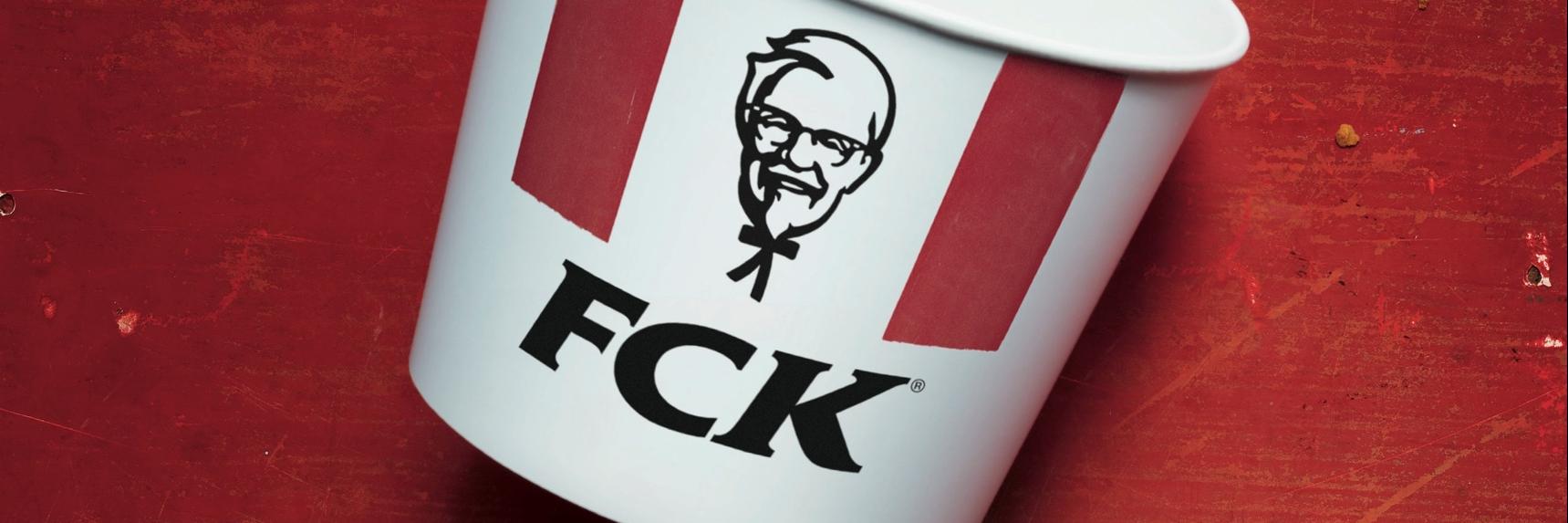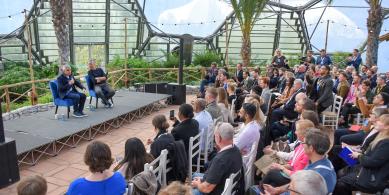It’s back! Beware of imitations. Welcome to the annual and original Challenger Brands to Watch list from eatbigfish (the company who literally wrote the book on challengers.) From the world’s ‘smallest’ beer to the Chinese behemoth redefining retail, these are the challengers we’re watching (and probably learning a hell of a lot from) in 2019.
Brands:
- KFC
- Universal Standard
- Hims
- Mailchimp
- Zume Pizza
- Veja
- Lidl
- Hema
- Clare Point
- ThirdLove
- Zwift
- Fair
- Twitch
- Exo
- Yoco
- Bird
- Nintendo
- Small Beer
- Narrativ
- Flack Pack
KFC
‘Chicken crisis’ two words that are now synonymous with one brand – KFC. It’s unlikely this phrase featured in its 2018 plans. However, when as many as 646 of your 900 UK chicken shops can’t get their hands on any chicken, I imagine your previous objectives evaporate. KFC has become the poster child for superb recovery.
With some punters hypothesising that the Colonel created his distribution disaster on purpose, everything is 20/20 in hindsight and from triumphs at Cannes and D&AD, it’s easy to see why the competition might be a little wary.
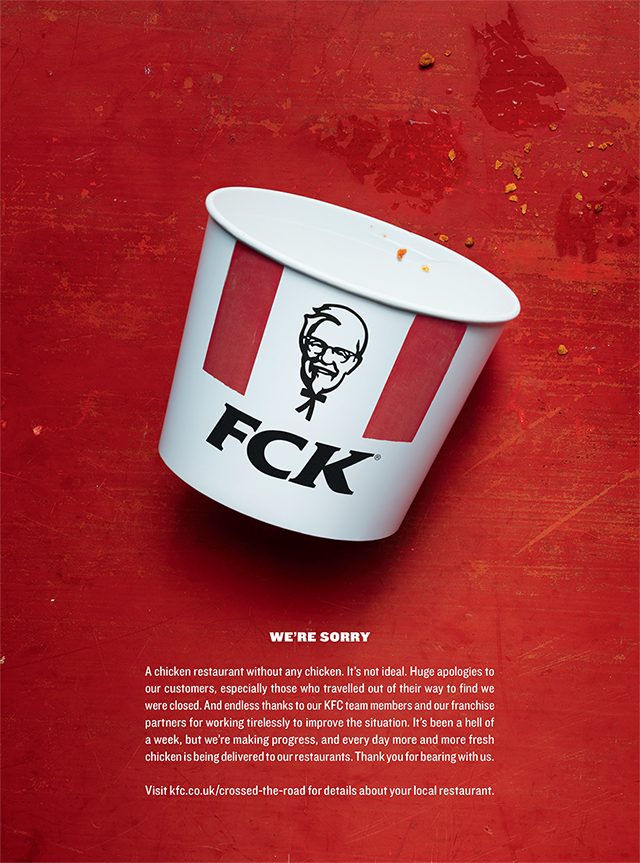
When life gave KFC lemons, the team didn’t just make lemonade. Instead (yes this is plagiarised from a birthday card) they grabbed the tequila and the salt. Mother’s quick witted FCK bucket response went properly viral. As a survey of one, I received screenshots from friends near and far (Sydney if you’re wondering). In a world of tight brand guidelines, where brands often intend to offend nobody, this was FCKing brave.
It was better than just brave, it was human. In addition to the f-word, they dared to utter the s-word and apologise, admitting their mistake. They also used their word-count to thank their people, those feeling the brunt of the problem.
“It was better than just brave, it was human.”
Lastly, they highlighted an overlooked advantage that they held over the competition – chicken freshness. Something the FT picked up on too. The crisis taught us something new about KFC and seeing the insane outpourings of love triggered some lapsed diners like me to give it another go.
This isn’t a story about one timely ad, KFC is already smashing it everywhere – dissing its own chips, turning chicken into flames, offering bowl haircuts and taking on turkeys at Christmas.
Marketing and PR at KFC have clearly found their swagger and if they have scope to make even bolder calls in 2019, it will certainly be their year.
Universal Standard
The fashion industry is one we all agree is in need of change, and over the last few years we’ve seen a generation of brands emerging with new approaches to right our fast-fashion wrongs. But, much as I applaud the new challengers like Everlane and Reformation for their commitment to ethical production and a much-needed transparency in supply chain, if your largest size is a 12 and 68% of American women wear a size 14 or above, it’s safe to say you aren’t the holy grail for the majority of the market.
But, after a marked increase in debate around representation and inclusivity, forged by the activists, style-bloggers and writers of the body positivity movement, the fashion industry finally seems to be waking up to the opportunity of those 68% (and their expendable income – the plus size category is considered to be worth around $21Bn).
However, while choice has increased in recent years, the brands catering to this market are still mostly either plus-size specific brands like Eloquii (recently acquired by Walmart), extensions of ‘straight-size’ brands such as Asos Curve or Mango’s Violeta, or an afterthought relegated to a dark corner of the store (or not even available in the store at all). So, things are getting better, but it’s not exactly a level playing field on the high street just yet.
Enter Universal Standard, a US-based brand on a mission to make the term ‘plus-size’ obsolete through a completely new size-inclusive approach – offering high quality well-designed wardrobe essentials to all women no matter their dress size. As the name suggests, this isn’t a brand catering for a niche - if you’re a woman who wears clothes, Universal Standard wants your business.
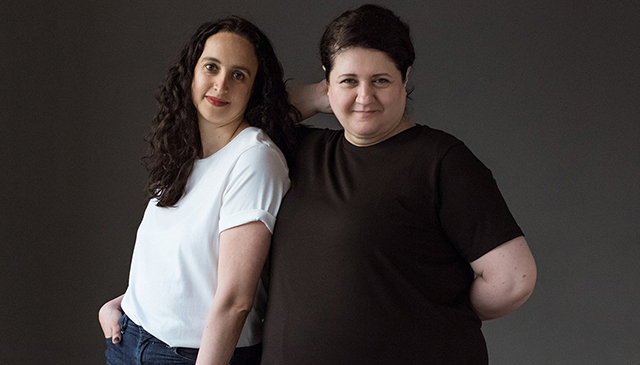
To challenge as a democratizer, be it democratizing by price or inclusivity or access, requires a real commitment to new ideas by necessity – widening access and changing perceptions requires new thinking, new models, new partnerships and new processes. In this context, Universal Standard is definitely deserving of its inclusion in Fast Company’s Most Innovative Companies 2018 list - from the ‘see it in your size’ feature on its website, negating the need to imagine how design might scale up or down, to its ‘fit liberty’ promise where certain investment items can be exchanged for free if you change size in future, the company is implementing innovative solutions to break down traditional barriers to purchase.
“We set out to create a brand for all of US. As we are.”
And it is making an impact and growing fast, in fact I wish I’d picked Universal Standard as a Challenger to Watch this time last year, because as they say themselves, they had “a monumental” 2018. Here’s a brief overview of the highlights…
- Raised $7m in series A funding from a number of high profile investors including Natalie Massenet, Gwyneth Paltrow and Blake Mycoskie.
- Partnered with J-Crew to design a capsule collection and help them scale up their range.
- Expanded their own size range to 6-32.
- Launched their ‘fashion freedom’ mission.
- Moved into workwear and activewear.
- Opened their first bricks-and-mortar store in New York - the “most size inclusive store ever” according to Vogue.
The year culminated in the launch of their flagship Foundation collection – 7 everyday basics for sizes 00-40 – a range which acts as both an entry level collection for new customers, and a piece of thought-leadership that showcases the brand’s broader mission.
“Everything we’ve done so far has led to this moment. We set out to create a brand for all of US. As we are. In its simplest iteration FOUNDATION is just that - the start, our groundwork, a promise of what’s to come.”
Perhaps their success will be judged on how and when the rest of the industry chases them to catch up, but Universal Standard is only three years old and it has the ideas, the momentum and the intention to make real change.
Hims
Why is Hims a Challenger to Watch in 2019?
Well it’s not because we’ve been seduced by its slick design, suggestive ads, or down-to-earth tone of voice.
Or that it’s on a clearly defined mission to redefine the status quo.
Backed up by a disruptive (in the classic sense) business model.
Running against a competitive set that, at its best, is really quite dull, and at its worst, does a good impression of a snake-oil salesman.
It’s not even that it is crystal clear about where it needs to overcommit in order to win.
A combination of all of these however, could be enough. Which is pretty exciting.
Though a few brands in approximately adjacent(ish) categories have shown how it might work, the core pharma category has been pretty inhospitable to challengers (or even brand) until recently. Perhaps ahead of its time, Help Remedies gave it a good shot before going quiet in 2015, but it’s taken the DTC revolution to breathe new life into the category.
And common sense would say this makes sense. It’s a category talking to people who want to fix something (whether they’re patients or HCPs), and not - at that moment - people interested in ‘brand’. Efficacy, naturally, will be king. And of course, if it’s going to work then it probably won’t come cheap.
Like a true challenger, Hims disagree with this conventional wisdom.
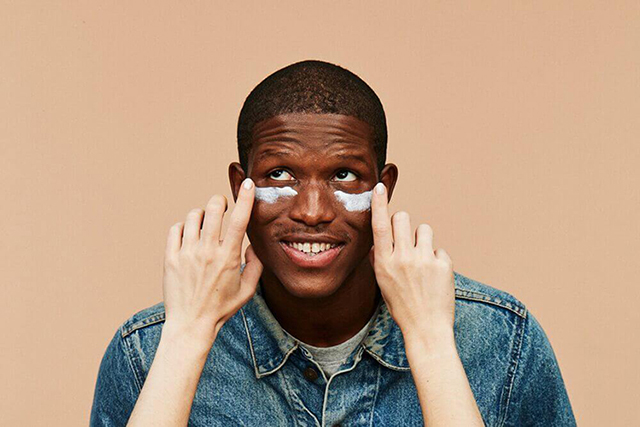
Superficially, Hims is a quintessential direct to consumer brand. It’s taken generic (and therefore cheap) versions of successful prescription drugs such as Viagra, and packaged them up in an easy to access (after a short online consultation) subscription model.
What really sets it apart is what it’s wrapped around the functionality and its value proposition. Far from just being another online pharmacy, Hims see the secret to long term success as lying in an overcommitment to the consumer experience at key touch-points - from leaning into the moment of unboxing, a focus on creating an excellent customer support team, to intentionally human and demystifying explanations of how its products work.
Finally, whilst it’s not the only brand in this space embracing slick design and irreverent comms campaigns, Him’s efforts have a clear goal in mind – by borrowing the playbook from the raft of other brands applying a lifestyle wrapper to functional products Hims is aiming to do more than just drive awareness, its intention is to normalise the issues men may feel awkward thinking about, let alone seeking help for. And it’s done so in a brilliantly reassuring way. Hims offer choice. Choice to embrace baldness, or not. Choice about when to get an erection. Or not. It’s up to you.
So, what’s to watch in 2019?
As its ambition to become a one-stop for all your wellness needs sees it broaden its range beyond the killer products that have made it famous, will it dilute its appeal or enhance it?
And can the launch of Hers, aiming to mirror Hims success but for a female target have the same impact in a category that’s already quite noisy?
Mailchimp
The chimpanzee logo, the sweaty hand hovering over the big red button before you send an email to thousands, the ad which pronounced its name ‘Mail-kimp’.
Mailchimp has always been a little weird.
So as it stretches its furry limbs into new markets in 2019, it’s great to see the company lean further into the quirks that first made it such an intriguing brand.
Through a new partnership with Square, Mailchimp users can now sell their products directly through landing pages. Until this feature was activated, landing pages were used mostly just to collect email addresses.
The partnership is part of a broader move to transform Mailchimp’s proposition from an automated email service to a ‘complete marketing platform’ offering landing pages, advertising and e-commerce. The transformation will see the Atlanta-based company compete for small businesses with established web and e-commerce platforms such as Squarespace, Wix and Shopify.
“So how has Mailchimp been preparing for its new and bold ambitions?”
Squarespace and Wix are both platforms that focus on creating ‘beautiful websites’ and have launched their own respective automated email services in recent months, which sees them now fighting for a chunk of Mailchimp’s original email business. Things could get messy.
So how has Mailchimp been preparing for its new and bold ambitions?
A rebrand by Collins in 2018 saw the visual identity grow up, without “buttoning up”. A new hand-drawn illustrative style is introduced that leans into Mailchimp’s quirky and expressive brand DNA. And a bold shift to a banana-like yellow (a nod to the chimp again right?) as its primary colour helps Mailchimp stand out in a sea of sameness from its competitors who all seem to have a thing for blue.

“Mailchimp has channelled its inner-Netflix and started producing its own original content.”
And in January this year, in a brilliantly off-the-wall move, Mailchimp has channelled its inner-Netflix and started producing its own original content. Yes, you heard right. Original content. Exclusively on Mailchimp.com.
“Both shows broaden Mailchimp’s world beyond product functionality and expand it into the universe of entrepreneurs, start-ups and - it will hope - popular culture.”
Taking Stock is a comedy/drama series about the day-to-day struggles of living the dream in a stock photography agency. It’s a little like HBO’s Silicon Valley. And Wi-Finders is an unscripted, original documentary series that tells the stories of people who have left their offices, work from anywhere, and are transforming the world around them.
Both shows broaden Mailchimp’s world beyond product functionality and expand it into the universe of entrepreneurs, startups and - it will hope - popular culture. Importantly, Mailchimp’s ability to connect with people on a very real and human (and occasionally weird) level is clear throughout each series and crucially that’s why this feels like it works. (Ok, If I’m picking holes, the acting in Taking Stock occasionally falls flat just a little…)
Episode one of Taking Stock sees the agency taking a “sad summer” photoshoot with its models looking depressed and in partial darkness because of a power cut. Whilst Wi-Finders’ Tokyo episode introduces us to Kenji – a 39-year-old male who’s occupation is as a friend-to-rent. Louis Theroux watch out.
Does it feel real? Mostly.
Does it feel human? Yes.
A little weird? Definitely.
And with Tom Klein at the helm as CMO, Mailchimp has someone who understands challenger thinking and the need to continuously drive imagination and differentiation into the brand and brand experience.
“We'll do a whole bunch of different versions of things, and it's the weird one that wins” Klein told The Drum.
We’ll see in 2019, if those small business customers are more drawn to the weird than the beautiful.
Zume Pizza
When SoftBank invested $375m in a 3-year-old pizza startup Zume, that valued the company at $2.2Bn… Wait, what?! That must be some slice.
Turns out it is. Part of Zume’s secret is the pizzas are part-baked in the company’s central commissary and then finished en route in a truck with dozens of mini pizza ovens on board. Software calculates the precise time it will take to get to you ensuring your pie is piping hot and crispy upon arrival. And it’s a healthier pizza too (if that’s not an oxymoron) as the crusts require no artificial stuff to keep them crunchy, like those from the big chains.
The pies are made in a “co-bot” facility — part robot, part human assembly — that can bang out pizzas at 10x the rate of a human-only pie shop. The cost savings of having no store fronts and fewer people is invested in higher quality ingredients and up-skilling people. Those whose work hasn’t been replaced by the bots are full-time employees with full benefits.
Zume claims this new model beats the conventional one on price, quality and speed of delivery, which if true is a compelling value proposition.
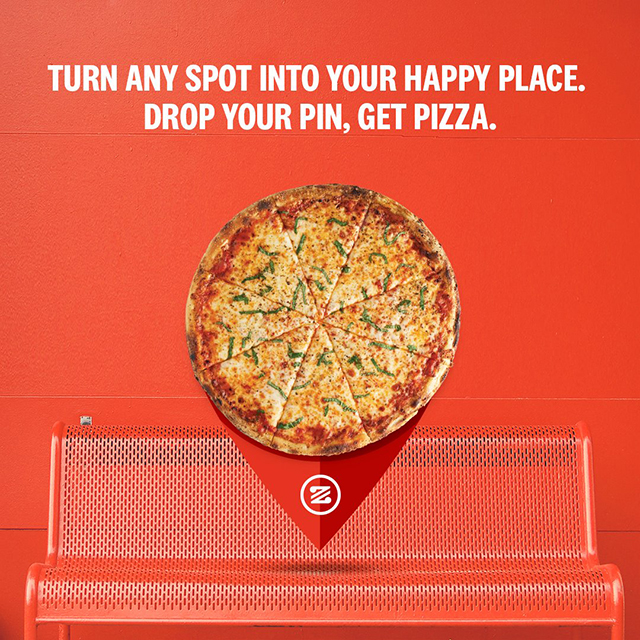
“In the end, what matters most to the consumer is the food.”
The reasons for that monster valuation though…? Well, this being Silicon Valley, Zume is less a pizza company and more a food service platform. It’s taking its robot know-how and “baked on the way” technology and preparing to disrupt other QSR formats. It’s this vision that has excited SoftBank.
Of course, in the end, what matters most to the consumer is the food. With the better pizza movement well underway in the US, led by startups like Blaze — who, among others, are doing for pizza what Chipotle has done for Mexican and Five Guys for burgers — expectations have been raised. And, in truth, Zume has had mixed reviews. It has a few issues to resolve:
First, execution. To be worth $2.2 billion the company needs to execute well 99% of the time. Or at least a lot better than Dominos, who’ve been no slouches themselves.
“It’s going to take something special to pry Dominos one-click app out of the white-knuckled hands of a Red Dead Redemption player.”
Two, marketing wizardry. Too many Valley types still believe Ralph Waldo Emerson’s maxim that “build a better mousetrap and the world will beat a path to your door.” Not in a world this full of distractions. It’s going to take something special to pry Dominos one-click app out of the white-knuckled hands of a Red Dead Redemption player.
Third, who’s going to buy all the pizzas if a good deal of America’s 15 million restaurant workers are out of work? Maybe that’s what UBI is for and why Andrew Yang should be the next US President. Now there’s a challenger to watch.
Veja
If you haven’t heard of it, you’ll recognise Veja’s signature pair – slightly retro, minimal, box-fresh, white trainers with a trademark ‘V’ in navy. Founded in 2004 by twenty-five-year olds Kopp and Morillion, Veja is proud that its growth has been slow and sustainable. To date Veja has sold north of 1.7 million pairs and is stocked in over 1,500 shops in 50-plus countries.
Seeing first-hand the living conditions of Chinese factory workers versus the power of fair trade in action, Veja’s founders set about building a different type of company. Fuelled by their belief that great products needn’t be reliant on broken supply chains and destructive production processes, and deducing that the dominant players were scrimping on production costs to fund their vast marketing budgets, they asked the ultimate challenger question - What if Veja did things the other way? It could spend five times as much on production, nothing on advertising and charge the same price per pair.
Since the brand’s inception, the noise about the human cost woven into many of our everyday clothes and kicks has become louder. In 2013, an eight-storey clothes production factory in Bangladesh crashed to the ground in less than two minutes. 1,134 people died and another 2,500 were injured. People were dead because of our gluttonous appetite for fashion. The brands we love, failed to sufficiently care about the people responsible for their profits.
Veja shines a light on another way, knowingly overcommitting to the much-treasured sneaker as their only product. As per their name, which translates to mean ‘Look’ in Portuguese, Veja’s sustainability credentials are dramatised via radical transparency.
Veja is surprisingly open about everything. Where materials come from (ethically sourced, organic and often recycled, of course), contracts with producers (agreed in advance and long-term) and the founders’ pay packets (on average 5000 euros a month). These are all decisions other brands make and information they don’t choose to share. Veja has transformed its operating model into a competitive advantage.
As much as Veja is a sustainable brand, it is in equal parts a stylish one. This isn’t landed via traditional marketing, but it has a seriously hot Instagram game. As said on its website ‘Instead of relying on marketing hype to have an impact, we'd rather rely on collective intelligence.’ The power of the collective comes through in its approach, both regramming influencers sporting Veja trainers and forming allies with like-minded brands.
In my world where ‘10x growth’ is often the brief, perhaps in 2019 we should all keep an eye on the quiet revolutionary that is Veja. “Our growth as a brand has to be organic, so that the supply of materials can grow at the same pace,” says Kopp. “We still have a great growth, but keep in mind that we have to grow slowly because we depend on our producers.”
Lidl
Lidl’s advertising is based on the idea of ‘Lidl Surprises’. Lidl is not just cheap, it’s surprisingly good quality is the message. Well Lidl continued the theme of ‘surprising consumers’ last year with its cheeky and subversive digs at upmarket retailers John Lewis and Waitrose.
First, it parodied the #EltonJohnLewis Christmas ad with the ‘It’s a Lidl bit funny…’ tweet telling consumers they could get a keyboard from Lidl for £89.99, rather than paying £872 for the piano that featured in the John Lewis ad.
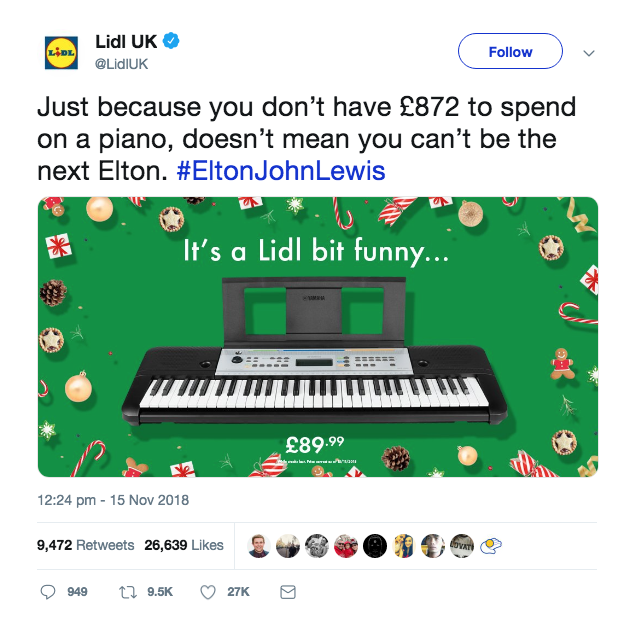
Then, full of mince pies (£1.49) and cheap (but quality) brandy, or perhaps just full of confidence from the attention its humorous twitter exchange with John Lewis had created, Lidl launched a billboard campaign to directly compare its products and prices with those of rivals Waitrose and Marks and Spencer.
The out-of-home advertising resembled guerrilla marketing ads, with Lidl’s cheaper prices appearing to be stuck with sticky tape over the top of well-known Waitrose and Marks and Spencer ads.
The recent creative has shone an interesting new light on Lidl. It has hinted at an aspect of the brand as a scrappy underdog, a stance which can often suit a value champion such as Lidl. And despite the German supermarket’s continual growth in the UK over the last six years - up from 2.8% in 2012 to 5.5% in 2018, it still has some considerable market share to steal from the big three British supermarkets in Tesco, Sainsbury’s and Asda.
“Brands that explicitly and publicly call out their rivals are a rare sight in the UK marketing landscape today”
What is especially interesting about Aldi’s recent behaviour, is that brands that explicitly and publicly call out their rivals are a rare sight in the UK marketing landscape today. Yet you only have to look to the US and at the recent success Wendy’s has had in its brilliant ongoing ‘Beef’ with McDonald’s to see the power of it as a challenger strategy.
Lidl has always been a challenger through its business model and pricing. But its recent behaviour demonstrated its potential as a challenger through its brand.
Interestingly, the rebellious pre-Christmas creative was TBWA’s last throw of the dice as Aldi’s creative agency after five years on the account. Accenture will take the reins on Lidl’s brand strategy from March 2019.
With Accenture on the account, it will be interesting to see whether this new scrappy underdog aspect to the brand is retained and allowed to progress from the opportunistic, to the strategic. It’s a new aspect that’s provided some of Lidl’s most provocative creative to date, and hinted at the potential of the brand as a brave and scrappy ‘Lidl’ challenger to the big retailers.
Hema
Hema is a Chinese supermarket chain that is primarily focused on fresh food. The brand name Hema Xiansheng literally means Mr Hippo (which gives the brand its logo), but is also a play on the phrase "boxed freshness”. Alibaba opened its first Hema store in January 2016 and now has over 100 stores across China.
Hema isn’t just a traditional store. It functions as a thought-leading testbed for the future of retail, driven by Alibaba’s ‘New Retail’ strategy. Its innovative solution to ‘bricks and mortar’ retail seamlessly integrates digital and physical retail, and, if you’re in retail, you should be taking notes.
The key to Hema is mobile. Every product on the shelves at Hema has a barcode which shoppers scan for product information like nutrition, price, customer reviews, and even supply chain information i.e. when it was delivered to the store and its origin. The app also suggests recipes and similar products, and saves the data of previous purchases for easy reordering. You can browse the store, use the app or facial recognition checkout to pay with Alipay and then either take your groceries home with you, or get them delivered within a 3 mile radius inside 30 minutes.
60% of each store’s sales come from online and the stores function as a distribution centre for those orders - Hema employees pick and pack the products from the shelves in reusable bags, which are then sent to the delivery hub via a system of conveyor belts on the ceiling.
But it’s not just about efficiency – Hema stores are experiential too. Chinese shoppers place a great deal of importance in the freshest seafood, so Hema has giant tanks where customers can choose their own catch and send it to the kitchen to be cooked before they leave the store. There’s also a huge restaurant where you can order by app, have your meal cooked fresh and then delivered to your table by a robot waiter.
“The key to saving traditional retail is to forget about tradition altogether.” — ALIBABA VIDEO
Alibaba has created in Hema a retail eco-system that epitomises its vision. As Jack Ma explains in a 2017 shareholders letter “’E-commerce’ is rapidly evolving into ‘New Retail’. The boundary between offline and online commerce disappears as we focus on fulfilling the personalized needs of each customer.”
Chinese consumers are years ahead of the US and Europe when it comes to embracing technology, and Alibaba is the company delivering it. If you want a glimpse into retail’s near-future - it’s happening at Hema.
Clare Point
Successful challengers are often led by a charismatic or visionary founder who comes into an industry with no extensive prior experience and asks an ‘intelligently naïve’ question like “Why does this industry operate this way?” and then interrogates the established conventions and rules that are usually perpetuated by and beneficial to the market leader(s). In today’s digital, online e-commerce age, we are seeing an explosion of challengers in a variety of industries taking this approach.
First there was Jeff Bezos who left Wall Street to start Amazon.com to sell books online and eventually create the most valuable company in the world realizing a vision of a single e-commerce destination to buy anything online. Then there was Tony Hsieh who left the world of internet advertising to start Zappos.com with a vision to deliver happiness and extraordinary customer service and satisfaction selling shoes and apparel without needing a physical store or sales person. More recently we have seen four MBA students launch Warby Parker to make buying prescription eyewear easier, more affordable and stylish as well as a group of designers conceive and launch Casper to challenge the old-fashioned (and creepy) mattress retail industry by designing and delivering a better and more affordable product, distribution and consumer sleep experience.
So it was only a matter of time before an ‘outsider’ would set their eyes upon the paint industry and category and interrogate why it has become so complicated, frustrating and out-of-date, especially for a younger generation.
Enter Nicole Gibbons — an interior designer and Emmy Award winning television personality — who created Clare to challenge the status quo of paint. Driven by a core belief that a fresh coat of paint has the power to transform a room and home into a more enjoyable living space, she couldn’t understand why the paint buying experience had become such a ‘headache.’
So why does every brand look and sound the same as the rest of the competition? Why is every product sold in the same packaging and in the same complicated retail experience? What’s the difference between ‘matte,’ ‘satin,’ ‘flat,’ ‘gloss’ and ‘semi-gloss’ finishes? Why are there a nearly infinite number of colors to choose from that seem to change in name every year? Why does every brand lay claim to the ‘color of the year’?
It’s because the paint industry has been dominated for decades by a handful of brands like Sherwin-Williams, Benjamin Moore and Behr, many of whom are produced and distributed by a dominant oligopoly of companies like PPG, Sherwin-Williams, Azko-Nobel, BASF and Valspar, and who operate with a retail store distribution model through their own stores, hardware stores or ‘big box’ home improvement retailers like Home Depot, Lowes and Walmart. The industry has deteriorated into a complex ‘sea of sameness,’ with every brand imitating one another and emphasizing their countless and custom variety of color selection, their superior paint quality and durability and the self-proclaimed trust that comes from being a centuries-old brand.
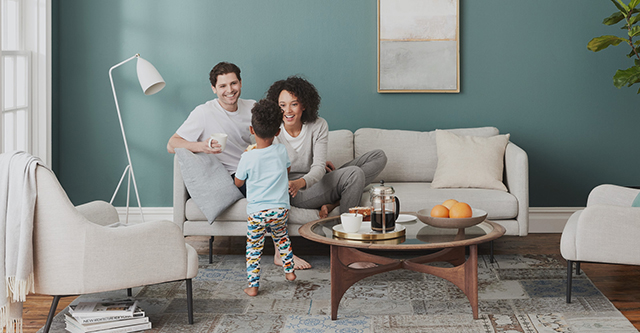
But Nicole and her colleagues had a different vision and mission — to eliminate the need to ever visit a [hardware] store for paint again and transform the industry and experience making it more convenient, accessible and a ‘joy, not a hassle.’ They set out to create a better way, an “expertly curated color palette, the highest quality paint, no-mess, no-fuss color sampling, and the best painting supplies all delivered to your door. Plus, guidance to get you going and keep you inspired along the way.”
“Who needs 50+ shades of beige anyway?”
Clare offers only 4 types of paint — Primer, Trim, Wall and Ceiling — available in a “perfectly curated palette of [only] 55 timeless colors” with youthful designer inspired names, because it proclaims “Who needs 50+ shades of beige anyway?” To help its customers make the right selection, it starts with “Clare Color Genius: an interior design-based color consultation paired with a high-tech algorithm that will recommend the perfect color for your space…so you’ll never have to sort through an endless sea of paint chips again.”
And speaking of paint chips, instead of imagining what your space will look like from a small 2”x2” square paint chip (usually presented along with 3-5 similar shades of the same color), Clare sends out much larger peel-and-stick to your wall swatches that can be reused all around your home — a perfect example of a ‘why didn’t I think of that’ idea that comes from seeing the category through a fresh set of eyes.
Clare also offers a simple assortment of essential painting supplies that come shipped with your order to make it a one-stop, turnkey shopping experience. It proclaims their paint and supplies are environmentally friendly (“Greenguard Gold Certified”) and come with a 100% customer satisfaction guarantee.
Even the brand name was chosen with an intention to sound more feminine than the masculine established brands, and its meaning is derived from the Latin word for “Brilliant” — exactly how they want to reinvent the paint experience.
It’s still early days, but given how little the paint industry has changed over the past 150 years, it’s likely this startup challenger will be taking a sizeable slice of this $155Bn category, which is why it’s one of our Challengers to Watch in 2019.
ThirdLove
In Season 2 of the West Wing, during a flashback to the primaries, Sam Seaborn advises candidate Bartlet to never create name recognition for the other guy. Always refer to him as “my opponent.”
Ed Razek, CMO of Victoria’s Secret clearly doesn’t have a Seaborn-type advising him, for in Vogue of all places, he made the comment, “we’re nobody’s ThirdLove, we’re their first love”, and handed ThirdLove founder, Heidi Zak, all the excuse she needed to weigh in on the furor Razek created with his demeaning comments about plus-sized and trans-gender models.
And weigh in she did. With a full-page ad in the New York Times, she expressed not only her disdain, but also her point of view as a brand, establishing ThirdLove as the thought leader in lingerie, ready to take even more business from a troubled Victoria’s Secret.
ThirdLove had every right to attack. It is women owned and led and makes “bras for every body”. It was the first to do ½ sizes in recognition that nearly half of all women fall between sizes. Its bras now run from 32AA to 40F (without talking about “plus sizing”) and come in a wide variety of skin tones. And its models reflect its strategy, of course.
Remember when Dove’s Campaign for Real Beauty was controversial for showing (gasp) real women? That approach is so much the norm now that Aerie’s Real Me campaign looks idea-less and barely worth a second look today — culturally a good thing, not so good for salience.
A new crop of challengers needs to push norms further still to create the distinctiveness they need, such as this beautiful work for ASOS.
ThirdLove is going to have to continue to push the envelope in how it thinks about the product and brand experience. How does it continue to drive Thought Leadership in a category that seems to have been unleashed now? What frontiers will it look to challenge next in user experience, business model, messaging?
And every bit as interesting is how Victoria’s Secret responds. Will they double down on Angels and the male-gaze? Do they bet that there is still a bigger market for fantasy over reality? Or will they change with the times and redefine entirely their worldview? With $3.2 billion in sales up for grabs these are big questions.
What would Sam Seaborn’s advice to Victoria Secret be? “Let Bartlet be Bartlet”, of course.
Zwift
The world of exercise has changed dramatically in the last decade. After years of grunt filled steel pumping, treadmill pounding and pet-bothering celebrity fitness DVD’s, consumers now have access to a spectrum of different experiences.
From the nightclub-cum-spiritualist vibes of SoulCycle, to the friendly “judgement free zone” of Planet Fitness, to the high tech HIIT workouts of OrangeTheory Fitness, a trip to the gym is not like it used to be. Each of these brands (along with hundreds like them) subvert the “no pain, no gain” narratives of the Gold’s Gym generation. A friend of mine swears by a new Aussie themed gym, called Training Mate. It’s like a gym, but apparently everyone calls you mate. Makes all the difference apparently.
At home, the internet and smartphones have created a revolution in fitness that goes beyond Rosemary Connolly and a tin of beans in each hand. Whether you’re stumping for a high end Peloton (guilty) or you’re doing an intense bounce around in front of Joe Wick’s free FaceBook live workouts, you are spoilt for choice.
But where general fitness training has been revolutionised, specialist training has lagged behind for years. Say you want to get better at a particular sport, improve your technique, put in an hour of practice. You are still largely limited to what has come before.
Enter Zwift, a game-stroke-training program that has taken the world of cycling by storm. For enthusiastic cyclists, fitness and form is everything… the weekend ride is a hallowed, almost religious experience. But like most things, the more you put in, the more you get out. The fitter you are before the ride, the better the ride turns out to be.
For years, Lycra-clad bikers have forced themselves to find a bit of fitness by setting up stationary trainers in their garages or wherever they can find a spare bit of space. These trainers effectively create the ability to peddle hard against resistance, but they are no-one’s idea of fun. Sweaty and alone, cyclists refer to these training rooms as “the pain cave”. A place to go and be miserable so that you can really enjoy your weekend.
Zwift changes all of that. Harnessing a new breed of “smart trainers”, originally designed to give the biker immediate feedback, Zwift has created the virtual world of Watopia (watts, get it?). This is the cyclists’ paradise, with lush scenery, huge climbs, and most of all company (and with it competition). Zwift has created the ability to jump on your bike and do a quick 50-miler with 20,000 others just before bedtime.

Like a video game, there are trophies and skill levels. Like a social network, there are friends and groups and likes. And like a modern fitness approach there is fun. This is a thriving, buzzy community of people united by a love of cycling, who want to be as good as they can be. It’s about pushing yourself hard, for a good couple of hours, then watching as the community celebrates your new PR.
It’s taken the cycling community by storm. Rides regularly depart with 3000 riders from around the world cycling together. The Alpes Du Zwift course was ridden 30,000 times in its first 5 days. In data released in February 2018, Zwift announced that over half a million people had gone for a ride on Zwift… which operates on an annual subscription model.
But cycling, while popular, is still niche in the world of sport. It’s an expensive habit to get into, and the kit required to get the best experience can run into the thousands of dollars (though you can get set up for around $300 plus your bike).
To broaden out, Zwift has launched a new running program, aimed at solitary treadmill runners looking to get those miles down as they prepare for 10k’s and beyond. Barriers to entry (provided you already have or have access to a treadmill) are far lower, and you can now find thousands of joggers taking to the sunny uplands of Watopia, competing in virtual marathons, even if they’re in their shed.
In 2019, Zwift has the potential to be the “Fortnite” of fitness… a virtual world populated by thousands of players, connected and pushing each other in a way that was never possible before, and breaking into popular culture. Here’s to bringing the joy to the pain.
Fair
Whatever else 2019 brings, it seems certain that the pace of change in the automotive category is going to pick up speed.
At one end of the spectrum, there’s a bunch of brands redefining what a car is: Electric? Hydrogen? A really bumpy underground train? Possibly (and more likely one for CTW:2022) even a helicopter-type-thing.
At the other end, there are brands catering to another fundamental shift in attitude away from the need to actually own a car, or even a driving licence. The decision around how we choose to get from A to B keeps on getting more interesting.
What’s not been very interesting (or at least, pleasant), for those who still want a car, or those who need one to work, has been how to pay for it. In the middle of all this innovation, a fundamental aspect of the category has been neglected.
A ‘typical’ new car has never been more expensive, costing roughly double what it did (in real terms) 60 years ago, and often accounting, on average, for more than half of a potential buyer’s gross annual income - well outside the reach of many. This isn’t likely to change as cars continue to become more complex.
And though it’s seen an explosion in demand over the last few decades, alternative financing models like leasing have remained complex and inflexible whilst consumer expectations, driven by a new generation of brands, have moved rapidly in the opposite direction. And of course, all this is equally true for the second hand car market.
The perfect environment for a challenger. Enter Fair.
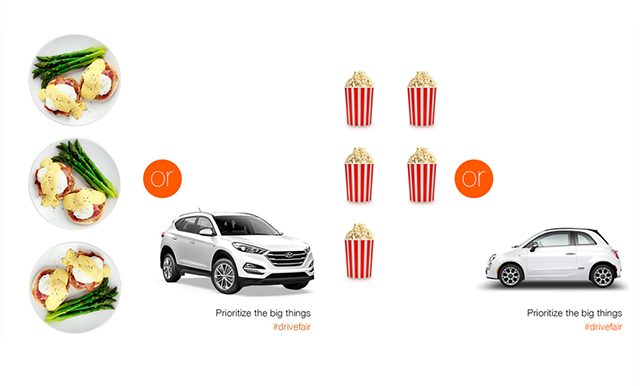
“A forward-thinking alternative to traditional car ownership.”
Fair straddles the line between the Zipcars of the world and traditional leasing, offering a new kind of hybrid contract of its own devising. In its own words ‘a forward-thinking alternative to traditional car ownership.’
An entirely app-based service, Fair has aimed to create a hugely streamlined ‘buying’ process, requiring nothing more than a photo of your driver’s licence to approve potential buyers. Once you’ve selected a car, you pay a one-off fee, and then monthly payments with no minimum contract (or termination fee).
Behind the scenes, Fair matches your requirements with cars from local dealers, and then buys them on your behalf.
For the customer, Fair promises a car that’s ‘yours’ alongside affordability, simplicity and flexibility.
For the dealer, there is an opportunity to access a wider customer base whilst still selling their cars to Fair at their forecourt price, and in theory increase what Fair calls the ‘velocity of ownership’ by encouraging customers to swap their cars regularly ‘we want people to have an SUV in winter, and a convertible in the summer.’
Fair is also intimately linked with Uber, through both a partnership to provide cars to its drivers (Uber sold its leasing business to Fair in early 2018), and through the leading provider of its $385m Series B funding, SoftBank, a key investor in ride-sharing platforms around the world.
So, what does 2019 hold for Fair? Well, its aim is to grow tenfold, cornering the market as a provider for ride-sharing vehicles, whilst at the same time, tap into an increasing acceptance of alternative ownership amongst the direct-to-consumer business.
Twitch
It seems odd to suggest that 2019 will be Twitch’s year, purely because 2018 was so squarely its year too. The live video streaming platform seemed to be having a “moment”... one of those times when the stars all align.
The platform was originally conceived as “Justin.TV” in 2007, a tool to allow anyone to create their own live, 24 hour “tv station” (some of you will remember following the life of Justin Kan, an early internet star, as he went about his day). However Justin.TV soon found its major audience with gamers who outstripped all other users of the platform.
Gaming and live-streaming were a match made in heaven, with audiences tuning in to watch charismatic streamers take on their favourite games and challenges. In 2011, a separate gaming focussed brand, Twitch, was launched and quickly dwarfed Justin.TV, which shuttered in 2014 to allow a complete focus on Twitch, and the company was bought by Amazon in the same year.
2018 felt like the year that nearly everything went right for Twitch.
In 2017 and 2018, the “battle royale” genre of gaming exploded, now lead by that titan, Fortnite (which the execs at Netflix see as their biggest competitor). These games are perfect for streaming… they are reasonably short, highly replayable and have a mechanism that naturally builds tension and promotes genuine moments of euphoria in those playing them… all of this, it turns out, makes for great watching.
Also in 2018, Twitch found its biggest breakout star to date, Tyler “Ninja” Blevins. Ninja has over 13m subscribers on Twitch, and his daily streams of Fortnite average 55k live viewers. Ninja’s (mostly) family friendly image and his ability to engage with a large audience has made him as close to a household name as any gamer has ever been. You may have seen him in ads for Samsung or hanging out with Drake (playing Fortnite).
“Twitch has shown time and again that it puts the community first.”
2018 was also the year that Twitch stole some ground on its biggest competitor, YouTube, which once again has had its approach to the streamer/creator community blasted for unfair monetisation practices and heavy-handed moderating. Casey Neistat, one of YouTube’s biggest stars, said “Twitch’s monetisation just feels so much more fair than YouTube’s”. In a fight for the world’s biggest streamers, Twitch has shown time and again that it puts the community first.
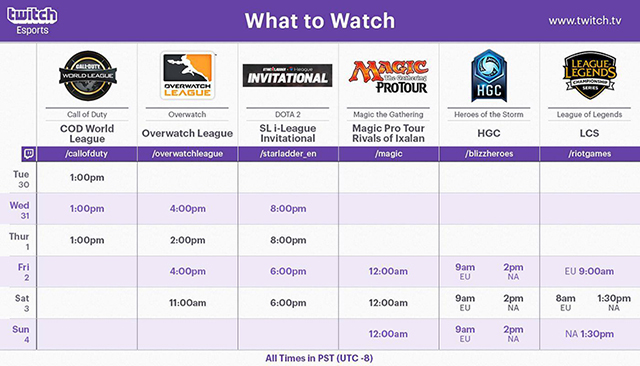
So, why feature it in 2019? Well, this could be the year that sees Twitch break into the mainstream conversation in the way that platforms like Instagram and Twitter have. As its existing audience gets older, and more and more stars are created, expect to hear more about things that have happened on Twitch in the rest of the media.
But also, there are signs that Twitch is ready to take on the bigger fights of our times. By focusing on the community, and improving the way in which the users of the platform can earn money from their actions, Twitch may just be showing other brands in the “gig economy” how it can be done. Can Twitch continue giving people the chance to make a living from the things they love? We’ll see in 2019.
Exo
Nearly a third of the world’s people already eat insects. But not in the West.
With the environmental consequences of livestock production increasingly laid bare, there’s some very rational reasons to ditch the meat and look to alternative proteins in 2019. It takes for example 1800 gallons of water to produce 1 pound of beef and just 1 gallon of water to produce the same amount of protein from a cricket.
But rational arguments alone rarely win.
And the ‘yuck’ factor associated with eating insects in the West is an emotional barrier that will need to be overcome if insects really are to become part of the accepted diet.
EXO, a Brooklyn-based startup, appears to have made the most inroads into moving insect protein from a niche product into mainstream consciousness. And that’s why it was acquired by Aspire Food Group, a commercial food-grade cricket farm in Austin, Texas, for an undisclosed sum in 2018. "It is one of the most successful, if not the most successful, brands in the entire industry,” Aspire’s co-founder Mohammed Ashour told Forbes.
Aspire will use the well-established EXO brand, makers of protein bars and protein bites, as its consumer-facing brand for all its current and future cricket-based products. It will also ensure that going forward, only Aspire’s crickets, which are branded ‘Aketta’, are used in EXO’s supply chain.
Co-founded in 2013, by Greg Sewitz and Gabi Lewis, the pair have had some success in positioning cricket protein for fitness fanatics and city-dwelling CrossFitters.
“EXO is unafraid to lean into the weirdness associated with eating insects.”
Many edible insect brands tend to hide displaying the insect itself within marketing. The insect itself if often seen as a risk so it’s often preferable to downplay the role of the insect and emphasise other, less divisive, ingredients or aspects of a brand for consumers.
But as a challenger, EXO chooses instead to lean into that risk.
A scribbled illustration of a cricket is proudly displayed on the packaging of every bar. Whilst slogans such as ‘Strange = change’ and ‘Weird is good’ champion the cricket and show EXO is unafraid to lean into the weirdness associated with eating insects.
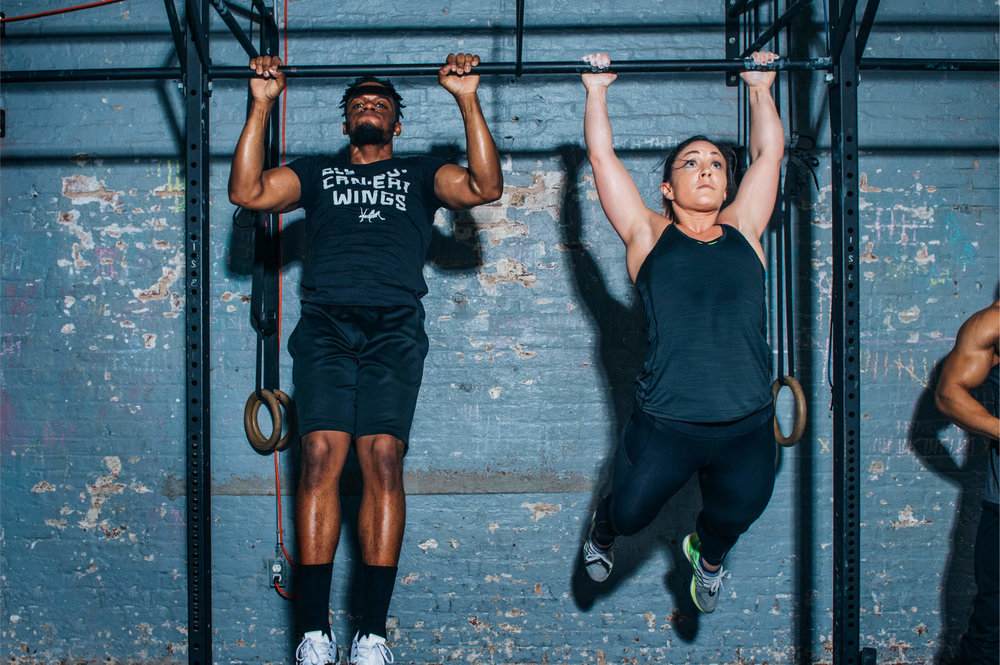
However, EXO also appears to know when to leverage cues from existing protein bar category conventions; muscled athletes provide the models for much of EXO’s digital communications, presenting the brand as tough, rugged and gutsy - all cues that are familiar and aspirational to a gym-going audience already intimate with existing protein bars and shakes. It’s a balancing act that ensures this challenger is interesting and different enough for consumers to try, but familiar enough to provide just enough reassurance to those willing to take the risk on something new.
The global edible insects market is expected to exceed $710m by 2024 according to a report from Global Market Insights. With EXO’s significant acquisition from Aspire, expect to see much more from America’s most popular insect protein brand in 2019. Perhaps this is the year you catch the entomophagy bug?
Yoco
The card payments market in South Africa was traditionally well-regulated and organised around the major institutions through their central interbank settlement platform – Bankserv. In the 2017 financial year it cleared R290Bn ($20.1Bn) worth of credit card authorisations. The card payment offering traditionally focussed on larger and medium sized businesses that are predictable and easier to reach.
Prior to 2015, if you were a startup, trying to establish your business and take card payments, you were at the mercy of this prevailing system which is dominated by the big financial institutions. To this day, as a small merchant applying for a payments device, you might wait up to three weeks for a bank representative to call back, let alone waste your precious time jumping through approval processes and filling in unnecessary paperwork.
The traditional infrastructure is quite a contradiction to what the country needs: more entrepreneurs who can start-up and scale quickly. In fact this is stated as part of the country’s vision in its National Development Plan: “we are traders, we are inventors, we are workers, we create companies, we set up stalls”.
Enter Yoco, who saw the bigger economic picture from the outset, seeing small business commerce as a crucial part of the equation of South Africa’s national success. Co-founder & CEO Katlego Maphai says "The key to driving the future in this country, and the continent, is through small business. They drive the majority of employment and build the economy."
In October 2013 Yoco began its journey to build a new way to accept a credit card through a mobile phone without the need for a traditional card point-of-sale system. Four entrepreneurs formed Yoco and decided to develop their own prototype working with about 500 merchants to deeply understand user interactions and build a bottom-up support model. Yoco believes that entrepreneurs have big ambitions for their businesses but never get the attention and support this deserves. Through this effort it turned the process of getting a card machine from weeks to less than 10 minutes, with no lock-in contracts and almost zero paperwork. In its first year Yoco processed R13-million in transactions (about $1m) and because of this intense focus on merchant needs, people love Yoco - it’s not often you hear customers praise their financial services company.
As a brand, Yoco is very much a Democratiser, representing the entrepreneur who is full of heart and hustle, but frustrated with a system that limits, excludes and protracts, a system built for the establishment not for a startup mentality.
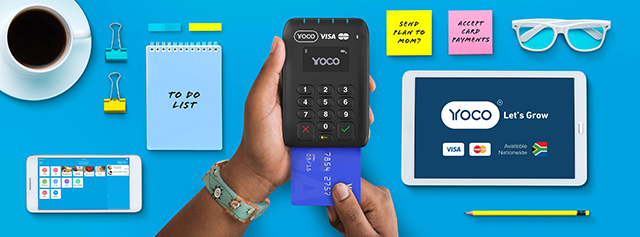
“Yoco has an express intent to challenge and push boundaries of how commerce works in favour of the entrepreneur.”
Yoco doubled from 17,000 to 34,000 business customers in 2018 and wants to continue the trend of doubling in 2019. Even more impressive is that 75% of this base had never accepted card payments before, meaning that Yoco is effectively building its own market which it estimates to be circa 1 million small businesses in South Africa alone.
Leveraging its cloud-based model and powerful in-house software platform, that analyses sales payment and revenue data, Yoco aims to open up new opportunities for merchant growth. In addition, partnerships with cloud-based accounting tools like Xero and others are extending Yoco’s capability to include business automation as a proposition, freeing up time for the small business owner to focus on customer engagement and growth. To further support this, Yoco has recently launched Yoco Capital, providing cash advances to small business owners.
Yoco has an express intent to challenge and push boundaries of how commerce works in favour of the entrepreneur. As it grows from its own startup origins, it’s committed to creating broad access to simple tools that make it easier for anyone to start, run and grow their business.
Bird
Life moves pretty fast doesn’t it? It just seems like a blink of an eye since we were talking (and worrying) about a bunch of transport disruptor brands flooding in to destroy our workers’ rights and make our journeys oh-so much easier. But here we are again, and this time the future has two wheels…
Bird was founded in September 2017 by Travis VanderZanden, formerly an executive at Lyft and at Uber – and just one year later the scooter share company reached its one millionth ride. This month the company was valued at $2Bn, operates scooters in 100 cities and has over two million unique riders. After ONE year.
The electric scooter boom is a potential transport solution for our congested cities. 40% of car trips in the US are under 3 miles, and the dockless scooters are convenient, cheap, and offer a low carbon, low-effort option for those journeys that don’t justify a car but are too long to walk.
For some people, this might seem a lazy descent into Wall-E style floaty chairs but, if this reduces the number of cars on the road, then perhaps the sidewalks littered with discarded scooters is a price worth paying? Or maybe the safety fears, lack of regulation and legislation for these new vehicles, and objections from local residents should be taken more seriously?
The two main brands currently battling it out for your electric-powered trip to the shop are Bird and Lime (currently in 93 US cities and 17 countries) - but the big guys Uber and Lyft have also entered the market, and new players like Wheels (and Hopr, Razor, Scoot, Skip, Spin, Cloud, Drop and Goin’) are all coming in to take a piece of the ‘shared mobility’ action.
The danger, as with all new categories fuelled by oodles of VC cash, is too much, too soon, too many players, not enough brand difference.
From the consumer standpoint there’s very little to choose from, the brands all look similar, have a similar product and seem pretty interchangeable in terms of messaging (although Bird does lean slightly more into the eco impact). So at the moment, it really comes down to access and distribution – who has the scooters that will be where you need them when you want them.
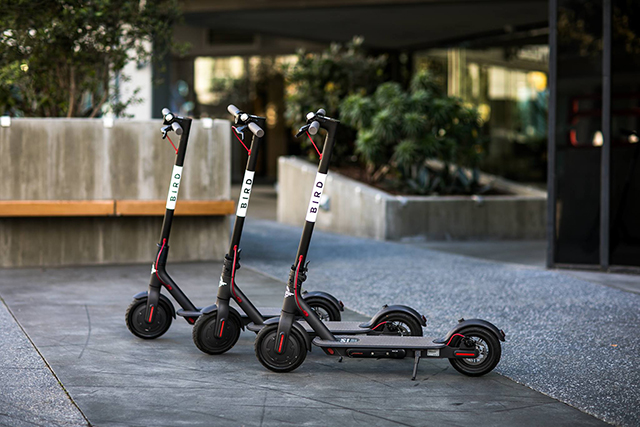
The scooter startups say they have learnt lessons from the collapse of the high profile Chinese bike-sharing unicorn Ofo, but have they really? The massive growth and ‘expand first, ask for permission later’ approach certainly seems familiar from the last tech transport ‘revolution’.
And the backlash has already begun as cities cope with the scooter invasion - after three brands (Bird, Lime and Spin) dropped 4000 scooters practically overnight into San Francisco in March without permission, the city banned scooters outright in August, and only two smaller players Scoot and Skip have been given permits to return for a pilot programme. Santa Monica (the epicentre of the scooter craze) has also issued permits to only a small number of brands - this time to the four main players, Bird, Lime, Lyft and Uber’s Jump.
For new markets, as well as regulation, it may be that the law needs time to catch up. In the UK, where Bird launched in London in November, it’s currently illegal to ride an electric scooter on the pavement or the road – so the only Bird scooters you will find are for the workers commuting through the private land of the Queen Elizabeth Park – essentially a trial to help the company’s lobbying case.
So, will I get the chance to scoot across London Bridge to the office every day? Will the bubble burst and send all those scooters to the tech graveyard? Will people ever stop looking lame riding a scooter? And most importantly when are we getting those floating chairs goddammit?
Nintendo
There were a few weird gaming news stories that caught my eye in 2018 - people couldn’t stop punching their horses in Red Dead Redemption 2, a gamer raised $340,000 for a trans charity by playing Donkey Kong on Twitch (and AOC dropped in for a chat about trans rights), and 9 year-old Fred’s dreams came true when he got a Nintendo Switch for his birthday....
Oh, did you not hear about that last one? Maybe it was more of a sensation on the Redstone family WhatsApp group than a viral twitterstorm, but I’d wager most of you had a similar experience last year as the Switch became the must-have console in most households.
The Switch has been a phenomenal success. Released in March 2017, Nintendo sold 19 million units in 15 months, making it the fastest selling console in US history. Thanks to those blockbuster console sales, multiple hit games and launching the re-released SNES mini, the company generated $9.6Bn in revenue in 2018.
This year it has targets of 20 million units shipped for a total of $10.9 billion in revenue and $2 billion in profit. That’s a lot of happy 9-year-olds.
Switch’s appeal is perhaps that it feels like a combination of everything that we’ve loved Nintendo for in the past – the portability of the GameBoy and the DS, the communal, inter-generational play experience of the Wii, and the revamped game formats from popular character franchises like Mario and Pokemon, all creating a perfect distillation of the brand’s wholesome charm for new and old fans alike.
It’s not all nostalgia - developers like EA, Bethesda and From Software have flocked to bring plenty of new ‘AAA’ titles usually found on higher tier consoles to the Switch, and Nintendo has committed to the independent smaller guys too, making it the most popular platform for indie game developers with a constant pipeline of new games to release.
But this isn’t “Brands who did well in 2018”, this is “Challengers to watch in 2019”, so why the inclusion of Nintendo on the list? Well, sometimes it’s not about watching you rise, it might be keeping an eye on whether you fall…we all remember the dizzy heights of the Wii and then the failure of the Wii U, and that’s a lesson that Nintendo surely can’t forget.
The real test for the brand may come this year. Not only are the PS5 and Xbox2 on the way, there are rumours that both Sony and Microsoft could move away from Blu-ray and use Nintendo style cartridges to combat increasing file sizes and slow installation times, and hints that PlayStation may even go head-to-head with a 5g portable.
Will the launch of the Switch 2 be enough to keep Nintendo on top of those birthday wish-lists into 2020? Or maybe Nintendo will take themselves out of the home consoles battle entirely?
At this point we can only speculate as to the next big thing. “Technology changes. We'll continue to think flexibly about how to deliver that experience as time goes on”, Shuntaro Furukawa, Nintendo’s President told the Nintendo news website Nintendo Everything. “It has been over 30 years since we started developing consoles. Nintendo's history goes back even farther than that, and through all the struggles that they faced the only thing that they thought about was what to make next.”
So, what is Nintendo ‘making next’? I know a certain 9-and-¾ year-old who can’t wait to find out.
Small Beer
Hands up who’s doing dry January? If you’re still on that particular wagon you have my utmost respect and I raise my glass to you. Instead of the full abstaining challenge (too difficult!) I’ve resolved to have a ‘dry-ish 2019’ as, like many others, I’ve started to change my habits for the long-term.
‘Mindful drinking’ is not just a media friendly buzzword, it points towards a potential real cultural shift in our attitude to boozing. In the UK (where a pint in the pub is as much a part of our national identity as a cup of tea) sales of non-alcoholic and low alcohol beer rose by 38% in 2018 compared to the same 12-week period the previous year, and in a recent poll 52% of people surveyed agreed that no-alcohol beer has become more socially acceptable in the past two years. Ocado, the UK online supermarket, reported that sales of non-alcoholic wine increased by 42% in 2018, with sales of no-and-low spirits and beers increasing by 87%.
Like the rise of plant-based eating, this changing of attitudes and boom in sales for low/no-alcohol is both fuelled by, and a reaction to, an explosion of options in a previously underserved category.
Our 2016 Challenger to Watch Seedlip has blazed the trail for grown-up sober sophistication, and it’s an exciting category to watch - we’re seeing a flurry of vinegars, kombuchas, non-alcoholic gins, and all manner of booze-free-beers from both mainstream and craft brewers looking to persuade us we can have it all – tasty, grownup drinks with no hangover at the end.
The Small Beer Company is one such craft brewer, and while there were many emerging brands we could have featured in this category, Small Beer gets the nod for its innovative, single-minded approach.
“Sustainability and innovation has been baked into the company’s approach from the beginning”
Founded in 2017 by James Grundy and Felix James, two former Sipsmith Gin colleagues, at Small Beer Co. low alcohol brewing isn’t an afterthought or line extension, it is everything – this “world’s first ‘small beer’ brewery” only brews at between 0.5 and 2.8% ABV.
By researching and reviving the brewing methods of the 1700s (when beer was safer to drink than water) Felix and James’ approach doesn’t de-alcoholise regular beer, removing the flavour at the same time as the alcohol, instead it uses a significantly longer lagering fermentation period to brew at a lower ABV as the norm.
Sustainability and innovation has been baked into the company’s approach from the beginning – to conserve water it has reduced the number of pints of water needed to create a pint of beer from 10 to 1.5, operates a ‘dry floor’ policy (which means the brewery floor is not systematically hosed down), and all packaging is recycled and recyclable – and it looks great too.
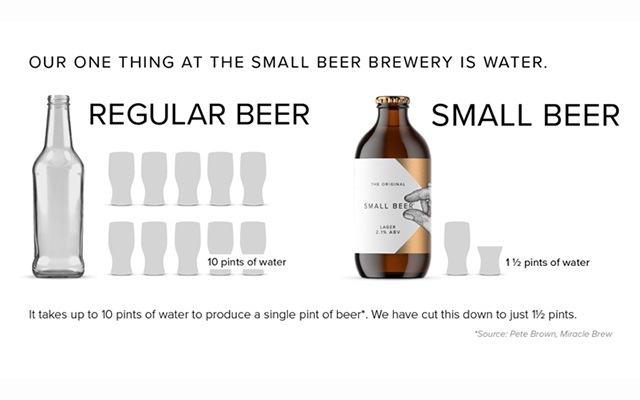
Currently available from most good craft beer stockists, and across the UK through Majestic Wines, this year sees a partnership with both Greene King and Fuller’s - so we’ll be seeing, and partaking of, a lot more small beer in 2019.
Narrativ
How did the Diane Von Furstenberg brand increase its web traffic year on year by ten times and bring in 29 times more revenue from online content? As the snappy saying goes - behind every e-commerce success is an AI powered affiliate link tech brand. Or it soon will be if Narrativ has anything to do with it.
So what exactly is Narrativ – and why should you care?
As a consumer you are increasingly likely to research online before purchasing, and it’s reported that 44% of us research recommendations for every purchase we buy. For example, we might search for ‘the best…’ - the best lawnmower, the best electric toothbrush, or in DVF’s case, the best wrap-dress. Those searches more often than not will lead to editorial content – particularly those from major publishers, which then often include a link to purchase – a powerful driver for e-commerce sales.
The problem with this model is that, firstly, our internet is getting a bit overloaded with ageing articles containing outdated links – leading potential consumers to a dreaded 404 page. Not great for users, publishers or retailers. Secondly, many of the functioning links are hardcoded to direct to Amazon through its affiliate program, giving Amazon the monopoly on those consumers clicks (a whopping 650million of them a year).
Founded in 2015 by former Mckinsey consultant Shirley Chen, Narrativ is an AI powered technology that not only gives publishers and brands greater control over these affiliate links, it is also able to detect and fix the dreaded broken links – meaning those potential customers always find their way to a purchase.
Like other affiliate marketing networks, the business operates on a revenue share model, which results in a win-win for both brands and publishers. But this isn’t just a tweak to the system, this is a challenger with a bigger mission to drive change. As Chen herself puts it…“We’re not building Narrativ to make an incremental improvement to affiliate marketing — we’re building Narrativ to create a fundamentally better ecosystem for publishers, retailers and consumers.”
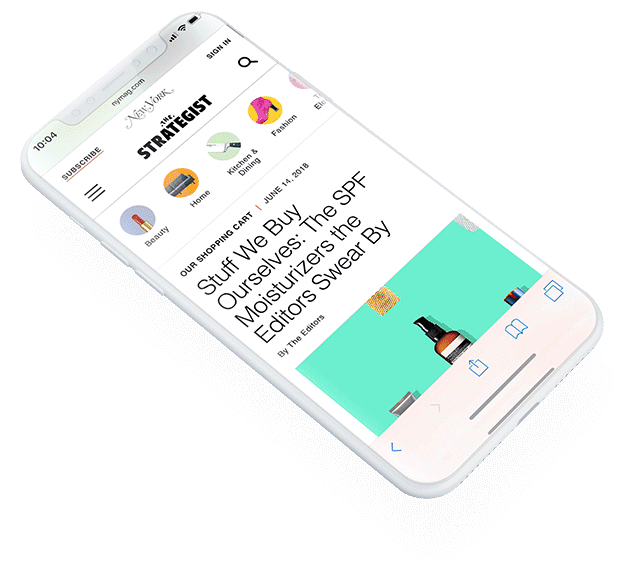
“This is a challenger with a bigger mission to drive change”
In just one year out of stealth mode Narrativ has made a strong start, raising over $3.5m in funding, fixing more than one billion broken links, winning a World Economic Forum Technology Pioneer Award and partnering with big brands like Dermstore, Ulta Beauty, and New York Magazine.
While the technology currently is only open to large retailers and brands, plans are in the works to expand the offer to small and medium businesses in the future. So, whether you’re a big retailer, a publisher or a small brand looking to break free from the clutches of Amazon – Narrativ might be the secret weapon you're looking for.
Flash Pack
Who wants to go on holiday alone? Erm, no one.
I am - or I was - the person that Flash Pack appealed to. I was a singleton in my early-thirties, so my annual leave was taken up on stag-dos, going to weddings, visiting family abroad or tagging along on couples holidays. Whilst fun, all of these trips made me feel more alone/single than before I took off, and like many my age, having worked solidly for years, I had a yearning to go somewhere far-flung and explore the world for myself.
So what do you do if you love to travel but don’t have anyone to go with?
You start a travel business. Flash Pack founders Radha Vyas and Lee Thompson met in 2012 via an online dating site that matched them based on their shared passion for travel, food and business. On their first date, fuelled by red wine, Vyas shared the seed of her travel business idea to cater for busy professionals like her who wanted to discover the world, go on inspirational holidays but didn’t have anyone to go with. All existing options for solo travellers were either too back-packer-y or appealed to an older generation – there was nothing in between.

Fast-forward to 2019 and Vyas and Thompson are married, and despite not having any experience in running a travel business, they are making a success of running Flash Pack. The company has recently been featured on both Forbes and the BBC, and is now valued at over £10m.
What is Flash Pack? It is group holidays, full of unique experiences, for solo travellers in their 30s and 40s.
It didn’t all start with a honeymoon.
When the business launched in January 2014 with a trip to Sierra Leone, they struggled to get awareness for what they were offering and thus had little traffic to their site. Thompson knew that sometimes the perfect holiday photo can make the whole trip worthwhile, so he used his experience as a photojournalist to capture a shot that would change the company’s fortunes. His ‘Epic selfie with Jesus’ – a selfie of him on top of Christ the Redeemer in Rio de Janeiro ahead of the FIFA World Cup went viral. When he sent the shot to every news outlet for free, asking for a backlink to his site in return, the site traffic shot up like an Icelandic geyser.

“Flash Pack knows its audience.”
What is Flash Pack’s secret sauce?
The biggest fears for a solo travellers has to be the painful admin and being surrounded by people you wouldn’t want to share a drink with, let alone a week on holiday. Flash Pack knows its audience. Its trips are packed with the sorts of adventures that will make your friends writhe with jealousy and it provides detailed questionnaires to get the group chemistry right. All the testimonials point to the amazing friendships and experiences people have which is surely what being single in your 30s is all about, right?
So what lies ahead?
With more people putting off long-term commitment, focusing on building successful careers and travel being such a strong social currency, I can only see greater demand for Flash Pack’s trips. The big trips are so successful that it is now offering mini-domestic ones here in the UK. Yes, the trips are probably a bit more expensive than organising the whole thing yourself, but for Flash Packers, the experience is priceless.
This piece first appeared on eatbigfish's site here.
Newsletter
Enjoy this? Get more.
Our monthly newsletter, The Edit, curates the very best of our latest content including articles, podcasts, video.
Become a member
Not a member yet?
Now it's time for you and your team to get involved. Get access to world-class events, exclusive publications, professional development, partner discounts and the chance to grow your network.

